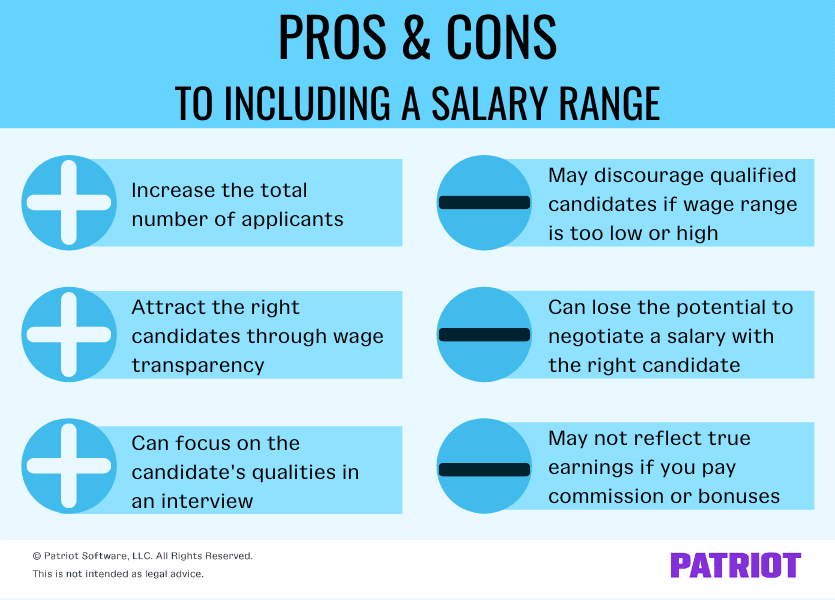When you’re ready to hire, there are certain steps you have to take to get ready. But, perhaps the most important step is attracting talent that fits your company’s needs. So, what must you add to job listings? Should you include a job description salary range? Learn the answers to these questions and more below.
What is a job description salary range?
Posting a great job description helps entice potential employees to your business. You may consider adding a wage range to your position description to make the job more appealing to the right candidates.
But, what is the salary range meaning? A salary range includes both the minimum and maximum salary you may start the employee at when they begin working for you. Employees look at the salary range to determine if the payment amount fits their needs before applying.
Does the law require you to include a salary range in a job description? Well, it depends on the state.
Salary range in job description state laws
Most states do not require you to include the salary range in the job descriptions you post or mandate disclosure of the salary range to candidates before you extend a job offer.
However, some states require you to either disclose the salary range to candidates upon request or include the salary range in the job description, including:
- California: Provide the salary range to job applicants upon their reasonable request only if the candidate has completed an initial interview
- Connecticut: Disclose the salary range for the position before or when you offer a candidate the position or at the applicant’s request, whichever is first. And, you must provide salary range information upon hire, a change in the employee’s position, or whenever an employee requests the information*
- Colorado: Provide the wage or wage range in the job description. State law also requires employers to include all compensation and benefits information in the job posting, including bonuses, commissions, health benefits, etc.
- Maryland: Provide the salary range to job applicants upon request
- Washington: Disclose the wage scale or salary range for the position upon applicant’s request, provided the request occurs after the initial employment offer
*Connecticut passed the new law on June 7, 2021 requiring employers to disclose the salary range to job applicants and employees for all positions. The law goes into effect on October 1, 2021 and expands the state’s prohibition of pay discrimination based on gender.
Want to impress your friends at a dinner party?
Get the latest payroll news delivered straight to your inbox.
Subscribe to Email ListThe benefits of a salary range in a job description
If you are not in a state where you must provide a salary range to applicants, you may still consider adding the compensation range to your job ad. After all, most state laws regarding salary range transparency relate to keeping salary ranges fair for all employees.
Other benefits of including a wage range in your job posting include:
- Increasing the number of applicants for the job. Some candidates won’t apply if a salary is not on the job description
- Attracting the right candidates who won’t turn down a job offer due to low salary
- Focusing more on the candidate’s qualifications during the interview rather than questions regarding salary
- Minimizing bias and increasing fairness to all current and potential employees
Additionally, not including a salary range does not mean potential candidates cannot find out the potential salary of the position. Applicants can use the Bureau of Labor Statistics or other sites (e.g., Glassdoor) to find the average salary for the position you post. Transparency with the compensation range gives candidates a clearer picture of what you pay for the position.
Cons of a salary range in a job description
There are cons to outright listing the wage range in a job advertisement. So, if your state does not require you to disclose the salary range for your open position, you may not want to include it.
Some cons of including a wage range in your job description include:
- Candidates may not apply if the salary range is lower than their desired salary range
- Potential applicants may feel underqualified for the position if the salary is too high
- Existing employees may be upset if the wages listed in the job description are higher than their current salary
- You lose the potential to negotiate salary with employees based on their experience, education, or other qualifications
- The listed salary may not accurately reflect the position’s actual earnings if you also offer bonuses or commissions to employees
So, weigh the pros and cons of adding the salary range to your job description before adding it to your website or job boards.

What must you include in a job description?
Now that you know the salary range job description section depends on your state, let’s look at other details you may need or want to include in your posting.
There are no federal requirements for what to include in your job description. However, you must comply with the Equal Employment Opportunity Commission (EEOC), Americans with Disabilities Act (ADA), and other labor laws.
Important items to add to your job description include:
- The title of the position
- A summary of the job
- All necessary tasks expected of the position to comply with the ADA
- Desired or required qualifications
- Preferred skills
- Wage type (e.g., hourly). The wage type helps ensure compliance with labor laws
- How to apply for the position (e.g., submit resume via email)
Items you may want to add to your job description include the:
- Salary range
- Hours for the position (e.g., Monday through Friday, 9:00 AM to 5:00 PM)
- Full or part-time status
- Company benefits (e.g., health insurance)
- Company or job location
- Description of your company and what you do
- Contact information for the department that can answer potential questions
If you require employees to travel for the position, you may wish to include that information, too. However, you do not need to specify the exact amount of time you expect employees to travel. Instead, you may list the expected amount of travel as a percentage of time (e.g., 20%).
Tailor your job description to your specific business. Consider the language you use to appeal to candidates. If your business is more creative, you may want to make the job posting reflect the nature of the work you perform. Is your business more technical? Think about reducing the creative language to help attract the right fit.
Make paying your new employees as easy as 1-2-3. Patriot’s payroll software lets you enter hours, approve, and pay your employees in just three steps. Get your 30-day free trial today!
